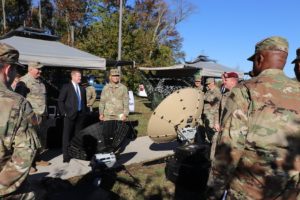The Army’s vice chief called modernization of the service’s tactical network “absolutely critical” to enabling massive data linkage between future weapon systems and as a key contribution to the future Joint All Domain Command and Control (JADC2) effort.
“Think about the integrated air missile defense up here. Think about the long-range precision fires that we’re developing. Think about the combat vehicles that we’re developing. Think about the future. You come right to the center of that, that’s where we’ve got the network. The network impacts all of those modernization efforts. It is at the center,” Gen. Joseph Martin said during a recent Foundation for Defense of Democracies event.

Overhauling its tactical network is one of the Army’s six modernization priorities, with the effort focused around capability drops every two years to better keep pace with industry’s technology innovations, and will include network transport capabilities, mission command applications and command post computing environments.
The Army has already completed its critical design review for its first tactical network modernization capability drop (CAPSET 21), with an additional 17 prototype deals in place to test technologies that may be included in CAPSET 23 or CAPSET 25 (Defense Daily, June 9).
Martin said the network will be critical to building the Army’s “kill web,” rather than a kill chain, that links together and synthesizes the massive amount of data to be collected by its future combat vehicles, helicopters and weapon systems.
“Instead of a kill chain, think of a kill web. Think linking. When you say any sensor, any shooter, think things that are way up in the orbit of this planet, things that are flying through the air, things that are below surface, things that are on the surface in the water, things that are on the surface on the land, and things that fly near the surface of the land, those are all potential sensors and shooters,” Martin said.
The Network Cross-Functional Team leading modernization efforts recently said the upcoming Project Convergence event, which will look at how the Army could form a new “sensor-to-shooter” network with its next-gen capabilities, will include testing range extension for connectivity and studying the potential for leveraging the network for artificial intelligence-enabled target recognition (Defense Daily, Aug. 11).
The ongoing JADC2 effort to build capacity to share data and link sensors across the services will require the Army’s integrated tactical network, according to Martin, with a focus on building a “common architecture, a common data standard, and the ability to create a repository of custody of information.”
“To do that you’re going to need to leverage, obviously the cloud, you’re going to have to leverage AI at the tactical edge, so that instead of collecting a picture at a location, sending it back to a location, and having an analyst or a computer look at that, and then make a determination on that, imagine being able to do that at the edge at the sensor, at the unmanned aerial system that’s flying, where it tells you there is this at this location, it sends that small data burst into the cloud and it’s available to everybody, so that within the custody layer, they’re able to understand where everything is on the battlefield. That’s where we’re going in the future,” Martin said.